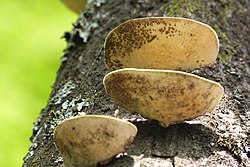Biology:Lenzites elegans
| Lenzites elegans | |
|---|---|

| |
| Scientific classification | |
| Domain: | Eukaryota |
| Kingdom: | Fungi |
| Division: | Basidiomycota |
| Class: | Agaricomycetes |
| Order: | Polyporales |
| Family: | Polyporaceae |
| Genus: | Trametes |
| Species: | T. elegans
|
| Binomial name | |
| Trametes elegans (Spreng.) Pat.
| |
| Synonyms | |
| |
| Lenzites elegans | |
|---|---|
| Mycological characteristics | |
| pores on hymenium | |
| cap is offset or indistinct | |
| hymenium is decurrent | |
| lacks a stipe | |
| spore print is white | |
| ecology is saprotrophic | |
| edibility: inedible | |
Lenzites elegans, also known as Trametes elegans and Daedalea elegans, is a common polypore and wood-decay fungus with a pantropical distribution found on hardwood hosts in regions including Australia, New Zealand, and Japan.[1][2] Though it is referred to as Lenzites elegans on this wikipedia page, The Species Fungorum places it current name as Trametes Elegans.[3] It has recently been considered a complex that is split into three different species: T. elegans, T. aesculi, and T. repanda. [4]
Morphology
T. elegans’ basidiocarp has narrow semi-dadeloid pores and is the color brown.[5] At the pore surface, they are yellow and there is a dark line that separates the lower context and the upper tomentum .[6] Defining characteristics of T. elegans include skeletal hyphae, thin-walled basidiospores, and a poroid hymenophore.[5] T. elegans has no stipe and has a corky texture. Its shape is flabelliform and is circular and sessile. When it is fresh it is flexible and becomes more rigid when it is dry (https://ncslg.cals.ncsu.edu/files/2014/05/Lenzites-elegans.pdf). The fruiting body of T. elegans is leathery and grows alone on dead wood. It is off-white, velvety, and has aerial hyphae in secondary mycelial culture.[7]
Ecology
T. elegans shares a commensalistic relationship with various host plants where it provides potection to the plant against assault from other pathogens. Additionally, T. elegans is endophytic.[5] As T. elegans belongs to the white rot fungi group, they are important in breaking down lignin from trees and they do so extracellularly, non-specifically, and non-hydrolytically. This is important for recycling carbon in forest ecosystems.[8]
Habitat
T. elegans prefers an intermediate temperature range of around 25-35 °C and can grow in both the soil and on synthetic media.[9] Additionally, they prefer to inhabit rotting wood and leaf litter in tropical forests.[5] They prefer hardwood forests.[5]
Geographical Distribution
Grows best in tropical hardwood forests and are found in places such as countries in Western Africa, Australia, New Zealand, Japan, and the southern United States.
Unique Aspects
T. elegans has potential natural antimicrobial possibilities. In a study, researchers found that compounds isolated from T. elegans were able to inhibit microbial growth. These compounds include ergosta-5,7,22 trien-3-ol, 5α,8α–epidioxyergosta-6,9, 22-trien-3βol, 5α,8α–epidioxyergosta-6,22-dien-3β-ol, ergosta-7,22-dien-3β,5α,6β-triol, Lupeol, and 9,19- cycloartane-3,30-diol.[10] These potential antimicrobial properties have been shown to apply to a wide range of bacteria and other fungi. The mechanism for this involves the reduction of oxidative stress and nitric oxides.[5] Not only do T. elegans have great potential as possible antimicrobial agents, but they also have the potential to degrade compounds including pesticides, polyaromatic hydrocarbons, PCBs, dyes, TNT, cyanide, azide, carbon tetrachloride, and pentachlorophenol.[11]
References
- ↑ Farr, D.F.; Rossman, A.Y.. "Trametes elegans". https://nt.ars-grin.gov/fungaldatabases/new_allView.cfm?whichone=all&thisName=Trametes%20elegans&organismtype=Fungus&fromAllCount=yes.
- ↑ Farr, D.F.; Rossman, A.Y.. "Lenzites elegans". https://nt.ars-grin.gov/fungaldatabases/new_allView.cfm?whichone=all&thisName=Lenzites%20elegans&organismtype=Fungus&fromAllCount=yes.
- ↑ "Species Fungorum - Species synonymy". https://www.speciesfungorum.org/Names/SynSpecies.asp?RecordID=178276.
- ↑ Carlson, Alexis; Justo, Alfredo; Hibbett, David S. (2014-07-01). "Species delimitation in Trametes: a comparison of ITS, RPB1, RPB2 and TEF1 gene phylogenies". Mycologia 106 (4): 735–745. doi:10.3852/13-275. ISSN 0027-5514. https://doi.org/10.3852/13-275.
- ↑ 5.0 5.1 5.2 5.3 5.4 5.5 Kanakasundar, Arivananthan (1 Jan 2023). "Trametes elegans: Sources and Potential Medicinal and Food Applications". SHLS Life Sciences 19 (1): 348-353. https://research.tees.ac.uk/en/publications/trametes-elegans-sources-and-potential-medicinal-and-food-applica.
- ↑ Wahab, Afshan; Pfister, Donald H.; LoBuglio, Kathy; Din, Siraj Ud; Khalid, Abdul Nasir (2021). "Some New Records of Trametes (Polyporales, Basidiomycota); from Pakistan". Journal of Clinical Medical Research 02 (02). doi:10.46889/jcmr.2021.2201. http://dx.doi.org/10.46889/jcmr.2021.2201.
- ↑ R. Dulay, Rich Milton; Center for Tropical Mushroom Research and Development, Department of Biological Sciences, College of Science, Central Luzon State University, Science City of Munoz, Nueva Ecija, 3120 Philippines (2021-01-30). "Nutritional and physical requirements for mycelial growth and basidiocarp production of Trametes elegans from the Philippines". Asian Journal of Agriculture and Biology 2021 (1). doi:10.35495/ajab.2020.06.339. https://www.asianjab.com/wp-content/uploads/2021/01/AJAB-2020-06-339.pdf.
- ↑ Osano, AA; Siboe, GM; Ochanda, IO; Kokwaro, JO (2005-01-17). "Biodegradation Properties of White Rot Fungi in Karura Forest, Kenya". Discovery and Innovation 16 (1). doi:10.4314/dai.v16i1.15660. ISSN 1015-079X. http://dx.doi.org/10.4314/dai.v16i1.15660.
- ↑ Sagar, Sukrit (2020). "Optimization of mycelia growth parameters forWild white rot fungi Trametes elegans and Trametes versicolor". Scopus Index Journal 12 (1): 4-14.
- ↑ Mayaka, Regina Kemunto; Langat, Moses Kiprotich; Njue, Alice Wanjiku; Cheplogoi, Peter Kiplagat; Omolo, Josiah Ouma (2019-11-08). "Chemical compounds from the Kenyan polypore <i>Trametes elegans</i> (Spreng:Fr.) Fr (Polyporaceae) and their antimicrobial activity". International Journal of Biological and Chemical Sciences 13 (4): 2352. doi:10.4314/ijbcs.v13i4.37. ISSN 1997-342X. http://dx.doi.org/10.4314/ijbcs.v13i4.37.
- ↑ Lara, Mayra A.; Rodrı́guez-Malaver, Antonio J.; Rojas, Orlando J.; Holmquist, Otón; González, Aura M.; Bullón, Johnny; Peñaloza, Nancy; Araujo, Elisa (2003-10-01). "Black liquor lignin biodegradation by Trametes elegans" (in en). International Biodeterioration & Biodegradation 52 (3): 167–173. doi:10.1016/S0964-8305(03)00055-6. ISSN 0964-8305. https://www.sciencedirect.com/science/article/pii/S0964830503000556.
Wikidata ☰ Q8007721 entry

